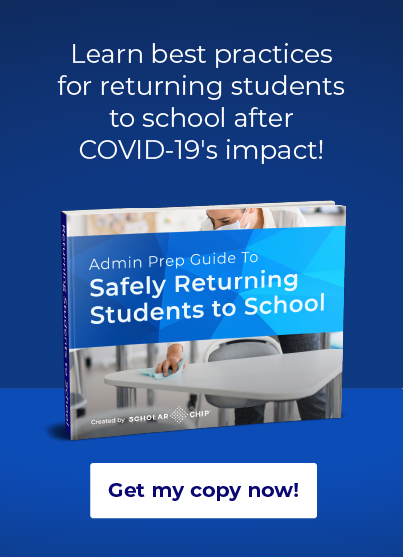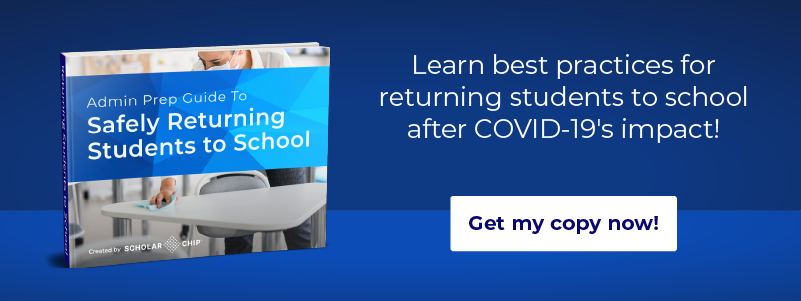The novel coronavirus hit hard and fast. Seemingly overnight, schools across the country were closed down, with little information as to when they might open again. Administrators scrambled to ensure that the infrastructure was in place for educational continuity. Talks about re-opening or staying closed were happening weekly.
In the end, nearly every school stayed closed for the remainder of the 2019-2020 school year. But while students are still reeling from missing end-of-year ceremonies and saying goodbye to classmates, districts are already developing ways to keep students and staff safe when they return to school.
With talk of a second wave and without a vaccine available, your district must have a plan. Self-quarantine, contact tracing, and temperature monitoring can only be part of the solution. Districts must follow the lead of retailers, airlines, and other public spaces: they must have a comprehensive cleaning plan to reduce exposure to the virus.
A plan to clean and disinfect your school does more than reduce the risk of infection. It also makes it clear to parents that you are taking steps to keep them and their children safe. This may mitigate the possibility of parents keeping kids home or moving them out of public schools.
The good news is that your plan doesn’t need to be complicated or costly—just comprehensive and consistent.
What’s the Difference between Cleaning and Disinfecting?
There is a difference between cleaning, sanitizing, and disinfecting. More specifically, the products that accomplish these are used and handled in different ways.
Cleaning. The purpose of cleaning is to remove dirt, germs, and other impurities with soap or detergent. Cleaning lowers the number of germs by washing them away, but it doesn’t necessarily kill them.
Sanitizing. Sanitizing lowers the number of germs on surfaces or objects to a safer level. It’s not separate from cleaning or disinfecting but is accomplished by these activities.
Disinfecting. This kills germs on surfaces and objects but doesn’t remove dirt.
Cleaning and Disinfection Tips for Your Schools
While the CDC has laid out a suggested list, here are more cleaning and disinfection tips that can make your plan and routine even more effective.
Use the Right Products in the Right Ways
Washing hands thoroughly with soap and warm water is more effective than hand sanitizer at killing and removing germs and viruses.
Similarly and when used with the right equipment, cleaners can be highly effective in removing a significant number of germs. However, to prevent simply spreading germs around, cleaning staff should change and sanitize their materials frequently. Fresh microfiber cloths should be used and changed out often. Mops should be used only once per room and then laundered.
Microfiber cloths are preferred over more traditional cotton or even disposable paper. They capture more dirt and germs and can be used again after being washed.
Disinfectants can be used in cleaning protocols as well. However, staff must use these products in accordance with the label’s instructions. Many disinfectants should be sprayed on and then left to dry, not wiped off immediately.
Clean Frequently Touched Areas Frequently
The CDC recommends that both cleaning and disinfecting be done on frequently touched surfaces, like door handles and light switches, at least once a day. Another cleaning and disinfection tip is to do this more often on certain objects and surfaces.
The following high-traffic and vulnerable areas, for example, may require attention several times a day:
- Door handles and knobs
- Bathrooms
- Lunchroom tables
- Computer equipment and phones
- Light switches
- Drinking fountains
Have a Cleaning Plan and Share It
Developing and documenting a well-regimented cleaning program should be at the top of your school-reopening checklist. It should be clear to all district staff that the process must be adhered to for everyone’s safety.
If your plan will be different for various campuses, ensure that this is documented and shared. For instance, if your elementary school has a different cleaning protocol than your high school or middle school, make sure the differences are clear. Everyone, including substitute teachers, should know the process as well as your cleaning staff does.
Once defined and documented, share your plan with parents and the community. This will help them understand the steps that you are taking to keep students safe and prevent unwanted dips in attendance because of safety concerns.
When you provide your plan, consider also sharing a cleaning and disinfection tips sheet for parents to use at home. Helping your district’s community stay healthy will also help protect your schools.
Limit the Number of Visitors
Another way to limit the spread of COVID-19 is to reduce the number of visitors in buildings and control their access. Visitors can be contagious without being aware of it and may not think to contact the school after they are diagnosed.
Maintain a policy that keeps visitors in the office, and have them practice social distancing. While not as effective a handwashing, have hand sanitizer available for visitors at all times. If they must go further into the building than the office, have staff accompany them and monitor their path closely to keep them in the areas where they belong.
Keeping schools, surfaces, and objects clear will be the best defenses that a district will have against illness when school resumes. As part of your overall safety plan, a cleaning and disinfection protocol will reduce risk, while documenting it will make it easier to share with your community. Beyond following cleaning processes, keep visitors away from areas beyond the office. Limiting access will help reduce the risk of infection.
ScholarChip offers unique holistic school safety services based on CDC guidelines to help schools reopen amidst growing health concerns. Through our advanced technology, built and designed for the K-12 environment, schools can identify risk and mitigate the spread of infection. Our solution includes fever screening, visitor questionnaires, symptom and vaccine tracking, in-school contact tracing, alerts, and notifications. Learn more about our advanced COVID-19 solutions or request a reopening strategy session today!


